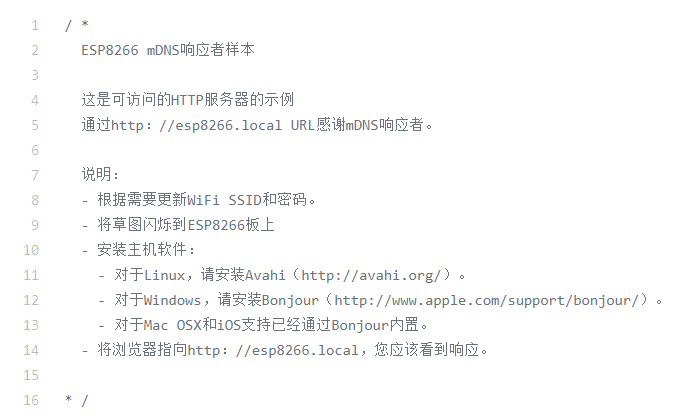(实例一)ESP8266 TFT(ST7735)彩屏-web刷图
https://www.arduino.cn/thread-42247-1-1.html

(实例二) 自己当AP时建立MDNS域名

/*
ESP8266 mDNS responder sample
This is an example of an HTTP server that is accessible
via http://esp8266.local URL thanks to mDNS responder.
Instructions:
- Update WiFi SSID and password as necessary.
- Flash the sketch to the ESP8266 board
- Install host software:
- For Linux, install Avahi (http://avahi.org/).
- For Windows, install Bonjour (http://www.apple.com/support/bonjour/).
- For Mac OSX and iOS support is built in through Bonjour already.
- Point your browser to http://esp8266.local, you should see a response.
*/
#include <ESP8266WiFi.h>
#include <ESP8266mDNS.h>
#include <WiFiClient.h>
#ifndef STASSID
#define STASSID "your-ssid"
#define STAPSK "your-password"
#endif
const char* ssid = STASSID;
const char* password = STAPSK;
// TCP server at port 80 will respond to HTTP requests
WiFiServer server(80);
void setup(void) {
Serial.begin(115200);
// Connect to WiFi network
WiFi.mode(WIFI_STA);
WiFi.begin(ssid, password);
Serial.println("");
// Wait for connection
while (WiFi.status() != WL_CONNECTED) {
delay(500);
Serial.print(".");
}
Serial.println("");
Serial.print("Connected to ");
Serial.println(ssid);
Serial.print("IP address: ");
Serial.println(WiFi.localIP());
// Set up mDNS responder:
// - first argument is the domain name, in this example
// the fully-qualified domain name is "esp8266.local"
// - second argument is the IP address to advertise
// we send our IP address on the WiFi network
if (!MDNS.begin("esp8266")) {
Serial.println("Error setting up MDNS responder!");
while (1) {
delay(1000);
}
}
Serial.println("mDNS responder started");
// Start TCP (HTTP) server
server.begin();
Serial.println("TCP server started");
// Add service to MDNS-SD
MDNS.addService("http", "tcp", 80);
}
void loop(void) {
MDNS.update();
// Check if a client has connected
WiFiClient client = server.available();
if (!client) {
return;
}
Serial.println("");
Serial.println("New client");
// Wait for data from client to become available
while (client.connected() && !client.available()) {
delay(1);
}
// Read the first line of HTTP request
String req = client.readStringUntil('
');
// First line of HTTP request looks like "GET /path HTTP/1.1"
// Retrieve the "/path" part by finding the spaces
int addr_start = req.indexOf(' ');
int addr_end = req.indexOf(' ', addr_start + 1);
if (addr_start == -1 || addr_end == -1) {
Serial.print("Invalid request: ");
Serial.println(req);
return;
}
req = req.substring(addr_start + 1, addr_end);
Serial.print("Request: ");
Serial.println(req);
client.flush();
String s;
if (req == "/") {
IPAddress ip = WiFi.localIP();
String ipStr = String(ip[0]) + '.' + String(ip[1]) + '.' + String(ip[2]) + '.' + String(ip[3]);
s = "HTTP/1.1 200 OK
Content-Type: text/html
<!DOCTYPE HTML>
<html>Hello from ESP8266 at ";
s += ipStr;
s += "</html>
";
Serial.println("Sending 200");
} else {
s = "HTTP/1.1 404 Not Found
";
Serial.println("Sending 404");
}
client.print(s);
Serial.println("Done with client");
}
(实例三) 自己STA连WIFI

在代码中,我们将包含一个额外的库
# include <ESP8266mDNS.h>
在该 库中,我们现在可以访问一个 名为 MDNS 响应器的类, 我们将使用它来声明一个对象。
MDNSResponder mdns;
使用此 对象,我们可以使用 begin方法创建我们将使用的 Web地址,并将其命名为“esp-01”。此方法需要的第二个参数是我们可以使用Wi-Fi对象的本地IP方法使用的Esp8266的IP地址。
mdns.begin(“esp-01”,Wifi.localIP());
添加一个条件语句,当它 评估为true时,它会向用户打印一条 消息,说 “M DNS 响应者已启动!”。
最后, 使用MDNS 内置对象调用Add service 方法
MDNS.addService( “HTTP”, “TCP”, “80”);
这需要三个参数。牛逼HESE参数描述的类型 ,我们要在广播服务 网络。在这种情况下,我们将在80上使用HTTP over TCP。
#include <ESP8266WiFi.h>
#include <ESP8266WebServer.h>
#include <ESP8266mDNS.h>
ESP8266WebServer server;
char* ssid = "YOUR_SSID";
char* password = "YOUR_PASSWORD";
MDNSResponder mdns;
void setup()
{
WiFi.begin(ssid,password);
Serial.begin(115200);
while(WiFi.status()!=WL_CONNECTED)
{
Serial.print(".");
delay(500);
}
Serial.println("");
Serial.print("IP Address: ");
Serial.println(WiFi.localIP());
if (mdns.begin("esp8266-01", WiFi.localIP()))
Serial.println("MDNS responder started");
server.on("/",[](){server.send(200,"text/plain","Hello World!");});
server.begin();
MDNS.addService("http", "tcp", 80);}
void loop()
{
server.handleClient();
}